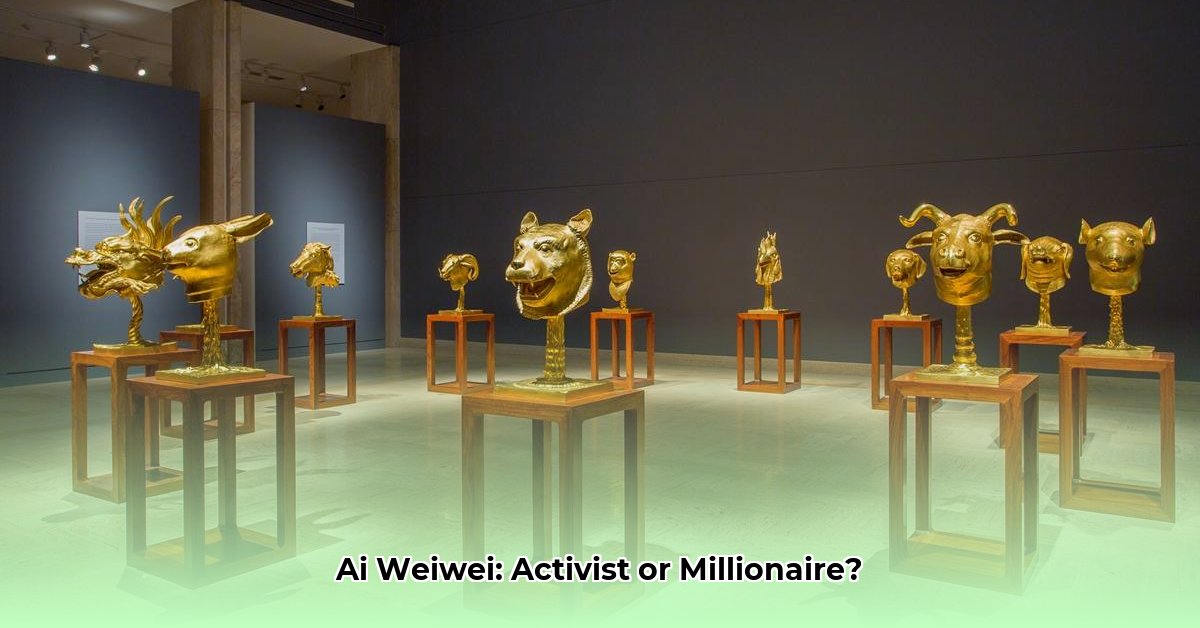
Ai Weiwei—the name conjures images of breathtaking installations, unwavering activism, and a defiant stance against authority. Yet, the question of his net worth introduces a fascinating paradox. He's famously dismissive of wealth, even calling money "poison," yet his art commands astronomical prices. This essay explores the intricate relationship between his artistic philosophy, his outspoken activism, and the undeniable market success that has made him one of the most significant contemporary artists.
The Unconventional Artist-Activist
Unlike many artists who meticulously cultivate their brand for financial gain, Ai Weiwei operates on a different plane. While his exact net worth remains undisclosed, the substantial sums his work fetches at auction are undeniable. The typical narratives surrounding wealthy artists—lavish lifestyles and a relentless pursuit of profit—don't apply to him. Instead, he seems to reinvest significant portions of his earnings back into his projects. This raises a crucial question: Is his financial success a byproduct of his artistic vision, or a necessary means to further his social activism?
How does a figure so publicly critical of capitalistic structures achieve such remarkable market success? Is it merely a reflection of his artistic talent, or does it showcase the confluence of art, activism, and financial value in unique ways? The answer, as we will explore, is complex and nuanced.
The Market Value of Dissent
Ai Weiwei's art and activism are inextricably intertwined. His work consistently confronts China's authoritarian regime, human rights abuses, and rampant censorship. This political dimension isn't merely a strategic marketing ploy; it’s the very core of his creative process. Remarkably, this outspoken activism significantly enhances his market value. Collectors recognize his pieces not just as aesthetically pleasing objects, but as tangible investments in a powerful voice that challenges the status quo. This unique positioning profoundly impacts his net worth, blending artistic merit with tangible social significance.
The price tags attached to his art reflect not just its aesthetic appeal, but also its political and social weight. This presents a potent question: does the very act of defiance—the risk inherent in challenging power—increase the desirability of his work? The market's answer appears to be a resounding “yes.”
Deconstructing the Enigma: Quantifying the Unquantifiable
Precisely determining Ai Weiwei’s net worth presents a formidable challenge. Public records rarely provide detailed financial information for artists, particularly those who don't adhere to conventional market practices. Moreover, his substantial reinvestment of earnings into his ambitious projects further obscures any clear financial picture. However, the substantial sums his artwork commands, even without precise figures, strongly suggest a considerable fortune.
This inherent ambiguity, however, is not a deficiency; rather, it highlights the inherent limitations of using purely financial metrics to evaluate an artist whose influence extends far beyond mere market valuation. It compels us to consider a broader definition of success, one that recognizes the intricate interplay of creative vision, social responsibility, and market forces.
The Future of Ai Weiwei's Financial Landscape
Predicting Ai Weiwei's future financial trajectory is as unpredictable as his art itself. The market demand for his work will undoubtedly continue to be influenced by his ongoing activism and its resonance within the global art world. His unwavering commitment—the conscious rejection of wealth accumulation in favor of artistic integrity—remains a potent statement.
The very uncertainty surrounding his net worth underscores this ongoing tension, making his case a subject of perpetual intrigue and debate. While some experts anticipate continued growth, reflecting the enduring interest in his work and its powerful message, others suggest that his unwavering focus on activism might inherently limit his financial accumulation, as he prioritizes social change over personal enrichment. Ongoing research into the art market and its intersection with activism remains crucial to a deeper comprehension of the complex forces shaping his financial future.
A Deeper Examination: Factors Influencing Market Value
While specific financial figures remain elusive, understanding the factors contributing to Ai Weiwei's wealth is critical. Auction records, though not comprehensively compiled in a readily accessible database, offer glimpses into his substantial market success. Individual pieces frequently fetch millions, suggesting an impressive cumulative value. However, this only represents a segment of his income; his participation in large-scale installations and commissions further complicates any attempt at a precise net worth calculation based on publicly available information.
This lack of transparency, however, underscores the challenges involved in evaluating an artist whose impact transcends simple market fluctuations. It forces a reevaluation of success beyond purely financial terms and encourages a more holistic understanding encompassing his sociopolitical contribution.
Key Takeaways:
- Ai Weiwei’s artistic methods, including symbolic destruction and recontextualization, are integral to the market value of his work.
- His unwavering sociopolitical activism significantly contributes to the desirability and perceived value of his creations among collectors.
- The intrinsic cultural and historical significance of his art plays a crucial role in its market position.
- A complex tension exists between his professed disinterest in material wealth and the high market demand for his pieces.
- The artist’s inherently provocative nature and his challenging works contribute significantly to their marketability and high price points.